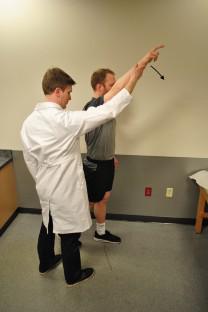Indian Journal of Orthopaedics ( IF 1.1 ) Pub Date : 2022-08-29 , DOI: 10.1007/s43465-022-00731-3 Justin W Arner 1 , Michael S Nickoli 1 , Tracye J Lawyer 1 , John E Conway 2 , James P Bradley 1, 3

|
Background
Recurrent posterior shoulder instability has become an increasingly recognized cause of shoulder disability, especially among athletes. The presentation can be vague and therefore its clinical diagnosis is often overlooked. Few diagnostic tests exist and these tests are difficult to perform in an anxious and apprehensive patient. Many also lack high specificity and do not effectively distinguish posterior labral tears from other shoulder pathologies. As a result, the authors worked to develop a new test, the dynamic posterior instability test (DPIT). The purpose of this study was to describe the DPIT as well as a modified DPIT test and to evaluate the accuracy of these tests in detecting posterior labral pathology. It was hypothesized that the dynamic posterior instability test (DPIT) would improve accuracy in the evaluation of posterior labral tears.
Methods
For a 9-month period, the DPIT and modified DPIT tests were performed on all patients evaluated for posterior instability of the shoulder. The records of all patients who had undergone a posterior labral repair (type VIII SLAP and posterior labral tears) were reviewed. The results of the DPIT and modified DPIT tests were compared to intra-operative findings. Anterior glenohumeral instability patients were also evaluated with these tests to serve as a control.
Results
Fifty-one patients had a positive and 3 patients had a negative DPIT test. Of the anterior instability patients, there was 1 positive and 19 negative test results. The sensitivity of the DPIT test was 94.4%, specificity 95%, the positive predictive value 0.98, and the negative predictive value 0.86. The results of the modified DPIT were the same as the DPIT test.
Conclusions
The DPIT and modified DPIT tests provide a valuable new tool when combined with history and other physical examination findings improve the accuracy of diagnosis of posterior shoulder instability.
中文翻译:

动态后不稳定性测试:盂肱后不稳定性的新测试
背景
复发性肩关节后不稳定已成为肩部残疾的一个日益公认的原因,尤其是在运动员中。其表现可能很模糊,因此其临床诊断常常被忽视。诊断测试很少,而且这些测试很难在焦虑和忧虑的患者中进行。许多还缺乏高特异性,并且不能有效地区分后盂唇撕裂与其他肩部病变。因此,作者致力于开发一种新的测试,即动态后验不稳定性测试(DPIT)。本研究的目的是描述 DPIT 以及改良的 DPIT 测试,并评估这些测试在检测后盂唇病理方面的准确性。据推测,动态后不稳定试验(DPIT)将提高评估后盂唇撕裂的准确性。
方法
在 9 个月的时间内,对所有评估肩部后不稳定的患者进行了 DPIT 和改良 DPIT 测试。对所有接受后盂唇修复(VIII 型 SLAP 和后盂唇撕裂)的患者的记录进行了审查。将 DPIT 和改良 DPIT 测试的结果与术中发现进行比较。盂肱关节前不稳定患者也通过这些测试进行评估,作为对照。
结果
51 名患者 DPIT 检测呈阳性,3 名患者呈阴性。在前不稳定患者中,有 1 例检测结果呈阳性,19 例检测结果呈阴性。DPIT试验的敏感性为94.4%,特异性为95%,阳性预测值为0.98,阴性预测值为0.86。修改后的DPIT结果与DPIT测试相同。
结论
DPIT 和改良的 DPIT 测试与病史和其他体检结果相结合,提供了一种有价值的新工具,提高了肩部后不稳定诊断的准确性。











































 京公网安备 11010802027423号
京公网安备 11010802027423号